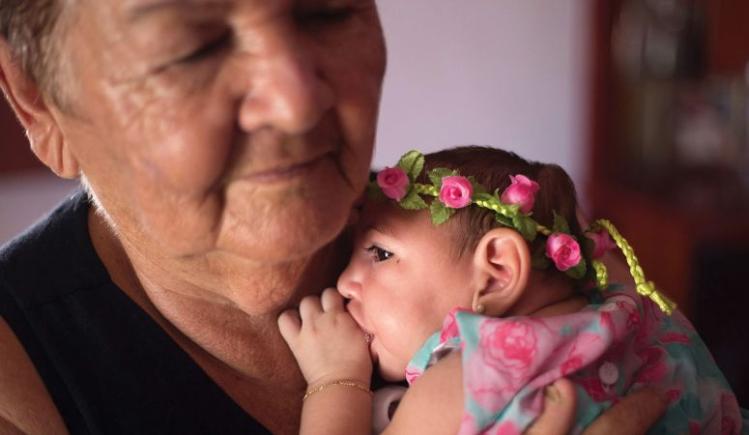
A woman feels under the weather, achy and feverish, and then recovers. All is well until she learns soon after that she is pregnant. Her mild bout of sickness could leave her baby with developmental delays, mental impairment, lifelong suffering. In 2016, that is the fearful scenario associated with the Zika virus, which arrived in the western hemisphere last year and is now spreading rapidly. But in the 1960s the same scenario was associated with rubella here in the United States. Remembering responses to the rubella crisis might inform our reactions to the current one. Advocacy for mothers, care for children with disabilities, and appreciation for the fragile, essential work of pregnancy should be our priorities, not recourse to abortion.
In 1964 an epidemic of rubella, or German measles, hit the United States. The disease had come before under different names in the late nineteenth century. But its arrival in 1964 was much more alarming. Researchers in Australia discovered a correlation between rubella and serious birth defects in 1941. Dr. Norman Gregg, a Sydney ophthalmologist, had noticed cataracts and unusual behavior among infants whose mothers had rubella during pregnancy. Other doctors observed more birth defects from gestational rubella, a group of problems eventually labeled Congenital Rubella Syndrome (CRS), including complications with the heart, vision, and hearing, and delays in mental development. Maternal rubella could also cause miscarriage or infant death. In 1960s America, the fear rubella generated was sharpened by the thalidomide scandal that preceded it. While the drug thalidomide was not approved for use in the United States, it had been widely prescribed in Germany and the United Kingdom in the 1950s and declared safe for pregnant women. But children exposed to it in utero were born with missing or malformed limbs. Pictures of “thalidomide babies,” which circulated widely in the United States, heightened public concern about the dangers of maternal behavior. They showed that a mother’s actions could, wittingly or unwittingly, wreak harm on her unborn child.
As historian Leslie J. Reagan argues in her study of America’s rubella epidemic, Dangerous Pregnancies: Mothers, Disabilities, and Abortion in Modern America, the outbreak helped reshape abortion debates in the United States, building support for termination when the fetus was likely to be disabled. Consistent with mid-twentieth-century emphases on family planning and responsible parenthood, women who sought abortion because of rubella were portrayed in news reports as acting conscientiously, sparing children from suffering, protecting a family’s other children from the difficulties and costs of a disabled sibling. While women could not be sure their children would be affected, the risk was especially high if the disease came early in pregnancy. Fears of having a “damaged” child helped make abortion a socially acceptable choice for white middle-class families and not only for the marginal. When the disease struck in the 1960s, therapeutic abortion was legal in some parts of the United States but access was limited, granted by hospital committees on a case-by-case basis. Testimony of “damaged” babies and agonized accounts of parents denied abortions and struggling to care for severely disabled children helped tip the balance of public opinion in favor of liberalized abortion laws.
Efforts to expand access to therapeutic abortion strengthened the push for abortion rights more broadly. Rubella-inspired reform efforts dovetailed with movements for women’s rights and reproductive-health changes. In California, a group of doctors, lawmakers, and citizens collaborated to advocate a Humane Abortion Act, though by the time it was passed in 1967 (and signed by Governor Ronald Reagan), it was more moderate than the law changes many abortion-rights advocates sought.
Catholics were prominent in opposing abortion as a response to rubella. Amid California’s 1965-6 debates, Catholic clergy, doctors, and laypeople testified against abortion in front of legislative committees. Priests preached against abortion at Easter Sunday Masses in California. In New York, amid that state’s 1967 debates, bishops signed a letter against abortion and ordered it to be read at Mass in churches across the state. Of course, Catholics were not united against abortion, and some organized groups to endorse legal access to it. But before and after Roe v. Wade, Catholics were conspicuous in opposition to legalized abortion.
THE ZIKA VIRUS now plaguing Latin America replays some features of the 1960s rubella epidemic. First identified in 1947, the virus was named for its source, the Zika Forest in Uganda. It spread through Africa and Asia, then to the South Pacific in 2007, and arrived in Brazil in May 2015. While the virus sometimes travels by sexual contact, it is mostly borne by two species of mosquitoes: the aedes aegypti and aedes albopictus. Like rubella, the Zika virus was tolerated without great alarm until a connection to birth defects was discovered. Though the link is still unclear, a spike in the number of cases of microcephaly—a condition in which babies are born with an unusually small head and brain—suggests causal connection between maternal exposure to Zika virus and fetal damage. Brazil has found over four thousand cases of microcephaly since October 2015. In February, public-health officials predicted the Zika virus would move through all of the Americas, except Canada.
Though the worry about Zika has spread widely, those most at risk are a very particular group. A few who get sick from Zika are at risk for Guillain-Barre syndrome, which causes temporary paralysis. Others experience symptoms like the flu, symptoms generally milder in strength than those caused by related viruses, dengue fever and chikungunya. But about 80 percent of those who get the Zika virus experience no symptoms at all. Public health officials are mainly concerned about childbearing women, who can pass the virus on to their unborn children, on whom it seems to have much more serious effects.
In contrast to the 1960s rubella outbreak, the Zika virus arrives with only a strong correlation rather than a confirmed understanding of how maternal sickness causes harm to babies. While consensus for therapeutic abortion was just beginning to form in the 1960s, childbearing women now face heavier pressure not to bring to term a pregnancy with serious fetal problems. In the United States, where abortion is legal and accessible, abortion for therapeutic reasons has become a fairly standard feature of medically supervised reproduction. Diagnostic procedures and genetic counseling are integrated into prenatal-care regimes, with abortion made available when abnormalities are detected. While parents in the 1960s had to make decisions about continuing pregnancy based on probabilities, fetal imaging now allows parents to detect abnormalities early and with considerable certainty. In contrast to the United States, abortion laws tend to be more restrictive in Latin America. It is illegal in Chile, Nicaragua, El Salvador, and the Dominican Republic, and subject to limitations in other Latin American countries. Some Brazilian legislators are aiming to tighten their country’s abortion laws in response to the virus.
Latin American clergy have offered a range of responses to the Zika crisis. Though 70 percent of Latin American adults still identify as Roman Catholic, the use of birth control is common. Bishop Leonardo Ulrich Steiner, secretary general of the National Council of Bishops of Brazil, upholds the traditional Catholic position against contraception, denouncing its use to control the Zika virus. But some church officials have taken a different line. Cardinal Odilo Scherer of São Paulo, for instance, acknowledges the use of contraception among Brazilian Catholics, which is likely to increase because of the virus. Strengthening the plausibility of birth control as a partial response to this crisis, in a February interview Pope Francis implied that contraception might be permissible under these circumstances since “avoiding pregnancy is not an absolute evil.” He cited the purported approval of Pope Paul VI for the use of contraceptives by nuns in the Congo who were at risk of being raped.
But while there has been a range of responses to the question of whether contraception can be used to combat the Zika virus, Catholic officials consistently reject aborting microcephalic babies. Cardinal Óscar Rodríguez Maradiaga of Honduras, an advisor to Pope Francis, observes that therapeutic abortions do not cure—they kill. Urging “due vigilance” in response to the Zika virus, Archbishop Bernardito Auza, the Vatican’s Permanent Observer to the United Nations, insists that “regardless of the connection to the Zika virus, it is a fact of human existence that some children develop conditions like microcephaly, and that these children deserve to be protected and cared for throughout their lives.”
PROTECTING THESE children must begin with protecting their mothers. Archbishop Auza has addressed the problem with compassion, but Catholic opposition to abortion is sometimes expressed without much sensitivity to the realities of pregnancy. Stern warnings not to use Zika as a justification for abortion can suggest that pregnant women are looking for any excuse to abort. What should come first is recognition of the struggle and sorrow of women who are unable to protect their children from the Zika virus and other such threats. The bearing of children entails special labor, relationships, and disciplines. There is a great deal to be done and said about this new threat to childbearing before abortion ever enters the discussion.
Alarmed at the dangers posed by the Zika virus, some have placed the responsibility for preventing harm squarely on women themselves. U.S. travel warnings advise women who are pregnant not to visit areas where Zika infection is possible. That might be doable. But Brazil, Ecuador, El Salvador, Colombia, and Jamaica have advised women to delay getting pregnant for a year or two. That recommendation is obviously much harder to follow. Not all pregnancies are planned, after all; nor are all women in a position to make and enforce unilateral decisions about contraception or abstinence. The counsel that women avoid danger by not conceiving seems as unrealistic as recommendations in the 1960s that women avoid exposing themselves to rubella, even though many of them already had children who brought the sickness home from school and needed to be cared for. The whole logic of prenatal precautions can magnify expectant mothers’ fear and sense of guilt, since everything from canned tuna to a glass of wine might harm an unborn baby. (The Center for Disease Control recently announced its recommendation that women who drink any alcohol at all should be using birth control.)
Pregnant women have long been blamed when anything goes wrong between conception and birth. For centuries people in the West accepted the Aristotelian theory that men provided the seed of a new person, while women merely provided a place and matter for its growth. If that place turned out to be inhospitable, it was the mother’s fault. Hence, men got all or most of the credit when reproduction went well, and women got most of the blame when it did not. Belief in “maternal impressions”—the idea that frightening sights or events encountered by the mother could be stamped on the child—continued even into twentieth-century America. Cravings were considered strong enough to mark an unborn baby: if a pregnant woman who wanted strawberries did not get them, the baby might be born with a tell-tale red blotch. In the middle of the twentieth century, doctors denounced belief in “maternal impressions” but warned women that their prenatal psychological problems could sicken, maim, or expel their babies. And in the past several decades, women have faced criminal prosecution for substances they deliver to a fetus. Cocaine use in the 1980s raised worries of an epidemic of crack babies, and more recently, methamphetamine and opioid addiction have drawn critiques of women who harm their children through those drugs.
The fact that the Zika virus wreaks its most serious damage through the bodies of pregnant women naturally focuses our attention on pregnancy itself. A woman expecting a child spends the months of her pregnancy doing a range of works intended for the child’s benefit, the chief of these being provision of nutriment and protection from harm. Some of this work is unconscious, as the pregnant body reconfigures organs to accommodate the fetus. But much of the work women do to protect their unborn children is intentional and difficult: avoiding certain foods or medicine, abstaining from alcohol, changing jobs, moving from one place to another, even taking to bed if there are complications.
Environmental hazards reach the next generation through the bodies of mothers. Many threats to a fetus are outside the control of the expectant mother, who may be unable to avoid drinking contaminated water or consuming toxins from food, soil, or air. As with many environmental harms, the poor are particularly vulnerable. The Zika virus, like rubella and certain environmental threats, perniciously inverts the protective nurture of pregnancy, leaving a woman powerless to ward off danger—or, worse, delivering harm to a child through her mother’s body.
WHAT, THEN, IS TO BE done about the Zika virus? Public health officials can work to limit contagion, eliminate breeding grounds for mosquitoes, educate populations at risk, improve understanding of the link between the disease and birth defects. Above all, they can work to develop a vaccine. Researchers now say that a vaccine for the Zika virus is at least eighteen months away. Past experience with rubella vaccination is instructive here. Nearly five years after the height of the American epidemic, large-scale public and private investment did finally lead to a rubella vaccine, but persuading people to get themselves and their children vaccinated was not always easy. It required making arguments about the common good and taking collective responsibility for the health of the children yet to be born. Most vaccines are intended to benefit the people to whom they are administered, but the rubella vaccination in the late 1960s and early ’70s was different. It prioritized children not in order to spare them the rash and fever, but for the protection of their mothers, their future siblings, and their own future offspring. Similarly, a vaccine for the Zika virus should be targeted to protect the work of childbearing, keeping children safe by protecting their mothers.
But maybe the most important lesson we can learn from the rubella scare is that the fear of birth defects should not lead to the further embrace of therapeutic abortion. We are already all too willing to accept the elimination of fetuses with defects or disabilities. Instead, the fact that the Zika virus has its worst effects on the unborn should refocus our attention on the welfare and safety of those who bear the burdens and risks of pregnancy and suffer most of the sorrow this virus can cause.
Please email comments to [email protected] and join the conversation on our Facebook page.
Share
Previous Story
Hidden in Plain Sight
Next Story
Elsewhere


